New to power meters? You came to the right place! We wrote the 2024 Power Meter Buyer’s Guide just for you. This guide is designed for those new to power who want to get up to speed fast. It contains everything you need to know before buying a power meter. What a power meter is, how they work, the different types, etc. Oh, and of course how you’ll benefit from using one! After reading this guide, you’ll know all the basics and will be well on your way to getting powered up!
This guide is geared towards cyclists that are new or relatively new to power. Our goal here is to hit all the important points, without going too deep into the weeds. After reading this guide, if you want to take your power meter knowledge to the next level, we recommend you check out our Power Meter Knowledge Center or our FAQs. We have lots of power meter related content and resources in those places. Ok, let’s get started!
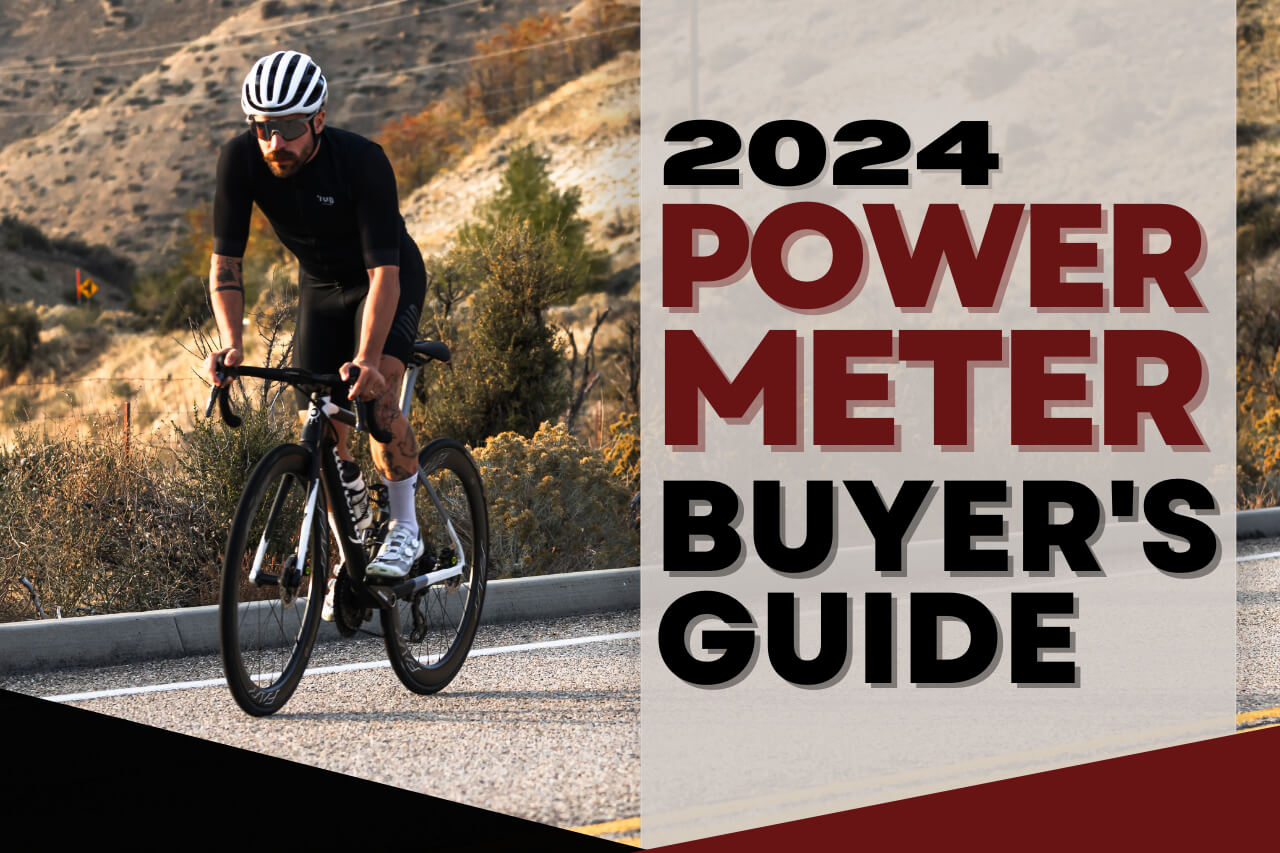
Power Meter Topics
1. Our Most Popular Power Meters
2. Affordable Power Meter Recommendations
3. What is a Cycling Power Meter?
4. How do Power Meters Work?
5. Benefits of Buying a Power Meter
6. Types of Power Meters
7. How to Choose the Right Power Meter
8. Cost/Benefit of Buying a Power Meter
9. The Power Meter City Difference
1. Our Most Popular Power Meters
To start things off, we thought it would be helpful if we listed some of our most popular power meters! The ones listed below are popular due to their affordability, compatibility across a wide range of bikes and reliability. This isn’t to say all of these power meters will be perfect for everyone, but if you are new to power meters, this is a great place to get started.
If you want to check out our complete selection, you can find them on our Power Meters page. The navigation menu along the top of our site also allows you to shop by manufacturer or power meter type.
Cost: Starting at $490
Bike: Road, MTB, Gravel, Track
Highlights:
- Dual-leg power measurement starting at only $490
- Proven accurate and consistent is all weather conditions
- Models to fit virtually every crankset and frame
- Features such as L/R Balance, BLE, Auto-Zero and more
The power2max NGeco, the company’s latest version, is a spider-based power meter. It measures power from both legs, is accurate and reliable. It also comes loaded with features like L/R Power Balance, ANT+ and Bluetooth, Auto-Zero and more. You can purchase the spider only which is installed onto your current crankset, or you can purchase a complete power2max crankset. The company makes versions for almost every crankset and frame.
power2max NGeco

Favero Assioma DUO

Cost: $759
Bike: Road
Highlights:
- The most affordable power meter pedals
- Highly reliable and consistent
- Independent left/right power
- Rechargeable
The Favero Assioma DUO offers all of the benefits of a power meter pedal: you get dual-sided power, it’s easy to use, is compatible with all bikes and can be moved from bike to bike. In addition, it’s more affordable than other pedals. For these reasons, it is one of our best-selling power meters. It uses IAV technology which means it’s accurate to +/- 1.0% and it has a great track record of reliability and consistency.
Cost: Starting at $330
Bike: Road, Gravel, MTB
Highlights:
- One of the most affordable direct force power meters
- Lightest power meter (9 grams of added weight per side)
- Easy to install
- Accurate to +/- 1.0%
The 4iiii PRECISION 3+ is a left side crank arm power meter that measure left leg power. It is lightweight, affordable and easy to install. 4iiii makes versions for both Shimano road and MTB cranksets and all 4iiii power meters feature 800 hours of battery life and a 3-year warranty.
4iiii Left Crank Arm

Favero Assioma PRO MX-2

Cost: $759
Bike: MTB
Highlights:
- The most affordable power meter pedals
- Highly reliable and consistent
- Independent left/right power
- Rechargeable
The Favero Assioma PRO MX-2 builds upon Favero’s rich tradition of making great power meter pedals. The PRO MX-2 is a dual-sided MTB pedal using Shimano SPD cleats. It is accurate, durable and lightweight at only 191.4 grams for the pair. Additionally, it can be used on any bike and is easy to move between bikes, making it a popular choice for many riders.
Cost: Starting at $380
Bike: Road, MTB
Highlights:
- Affordable, dual-leg power measurement
- Compatible with many road and MTB cranksets
- Lightweight: MTB – 85 grams | Road – 105 grams
The Sigeyi AXO Power Meter is one of the most affordable spider-based power meters available. It measures power from both legs, is lightweight and +/- 1.0% accurate. In addition, the Sigeyi allows riders to add a power meter to their crankset without the need to change cranks, chainrings or bottom brackets. A spider-based power meter like this one also provides left and right leg power balance measurements.
Sigeyi AXO
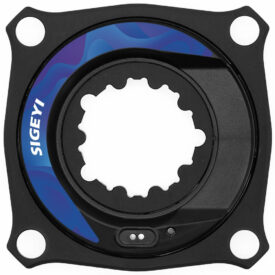
SRAM Rival AXS Crank Arm

Cost: $263
Bike: Road, Gravel, CX
Highlights:
- Easy installation
- Affordable, crank based power measurement
- 400-hour battery life
The SRAM Rival AXS Crank Arm is an affordable and easy way for riders to add power to their SRAM Rival cranksets. The Rival power meter is available in a variety of crank lengths and has options that are compatible with both regular and wide chainlines. It also features +/-1.5% accuracy and the AAA battery can be easily replaced.
2. Affordable Power Meter Recommendations
Power meters have traditionally been an expensive upgrade for riders. Over the years, power meter technology has continued to improve and become less expensive. There are now affordable, accurate and reliable options that allow most riders to equip their bike with a power meter.
Specifically, two of the most affordable power meters available are the Sigeyi AXO and Magene P505. These are spider-based power meters that bolt to your existing crank arms and measure power from both legs. Prices start at less than $400 and these power meters are +/- 1.0% accurate with advanced features such as auto-zero. In addition, Sigeyi and Magene make versions for almost any crankset including road, gravel and MTB. Either of these power meters would be a great and affordable way to add power to your bike!
For more information, please have a look at our our FAQ: power2max vs. Sigeyi vs. Magene Power Meter Spiders where we compare the specs and differences between these two options.
Sigeyi AXO
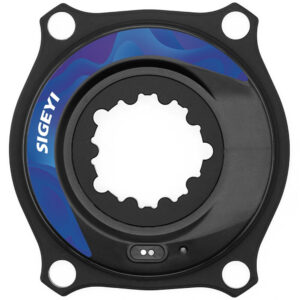
Magene P505
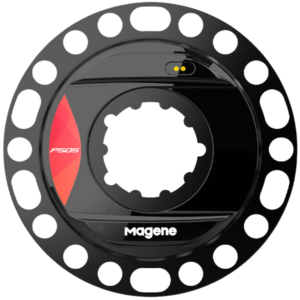
3. What is a Cycling Power Meter?
A power meter is an electronic device that measures the power, or torque, the rider generates when they rotate the crank arms. A power meter literally meters (hence the term ‘power meter’) your power. Power, measured in watts, is a measurement of the work you do on the bike and is the most accurate way to measure and gauge your effort.
There are several different types of power meters and differ by where they are located on a bike. For example, you can buy a crank-based power meter, where the power sensors and electronics are built into the crank. Or you can buy a pedal-based power meter where the sensors and electronics are located in the pedals. You can put a power meter on virtually any bike – road, mountain, track, cyclocross, BMX, etc.
As an example, here are two popular power meters. The first is the Favero Assioma DUO, a pedal-based power meter. The Assioma measures power in the pedal body and places its electronics in pods that are mounted on the pedal spindles.
The second is a 4iiii Precision 3+ Pro Shimano DURA-ACE 9200 Dual-Sided Power Meter. The 4iiii is a complete crankset and measures power using sensors and electronics placed along the inside of each crank arm.
Favero Assioma DUO

4iiii Precision 3+ Pro Shimano DURA-ACE 9200

4. How Do Power Meters Work?
Strain Gauges
Most power meters measure torque using a strain gauge. A strain gauge is a small electronic device whose electrical resistance varies depending on how much resistance (strain) is put on them. In the case of a crank arm-based power meter for example, the strain gauge measures how much your crank arm is flexing when you push down on the pedals.
Graphical depiction of a strain gauge

Using electronics located within the power meter, the strain gauge converts this flex into an electrical resistance. Based on the amount of electrical resistance, the power meter can calculate how much torque the rider is generating.
The number of strain gauges, their alignment and the materials used all determine how accurate a power meter is. The precise measurement of torque is the biggest challenge power meter manufacturers face. The microscopic bending that the strain gauges must precisely measure is the key to accurate results. It requires an extremely high level of engineering and precision to fit the strain gauges within a power meter.
Cycling Computer
Data from the power meter is transmitted in real-time to a handlebar mounted computer or watch (aka head unit) via a wireless protocol such as ANT+ or Bluetooth SMART. The head unit displays power data such as current, maximum and average power. It also serves as an all-around cycling computer, displaying things like heart rate, speed, distance, time and much more. Note that power meters that feature Bluetooth SMART (the vast majority of power meters), can also interact directly with smartphones and tablets.
As an example, here are two popular head units:
Garmin Edge 540

SRM PC8
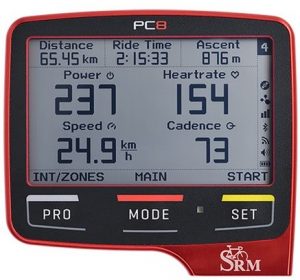
5. Benefits of Buying a Power Meter
In cycling, many things affect how fast you go. Winds, gradients, rider weight, road surface and many other factors determine your speed. This means it can be difficult to gauge your effort based on speed alone. A power meter allows riders to measure their efforts regardless of these factors. They provide an objective measurement of real output. This affords the rider numerous advantages.
This is why power meters have become essential tools for cyclists of all levels, their coaches as well as sports scientists – who use them as a fundamental way to measure and improve cycling performance. Power meters can unlock more endurance and speed than any other training tool.
Here are just a few of the ways you can use a power meter to improve your performance:
1. Eliminates Guesswork
Perhaps the biggest advantage to a power meter is that it removes the guesswork that goes into training and racing. With a power meter, you can quantify exactly how hard you are working (as your effort is measured in watts). Many people use a heart rate monitor in their training. This can be a great training tool in addition to power meters, but training with only heart rate can have limitations. While power can be measured instantly, heart rate is a lagging measurement. This means during training, it takes time for heat rates to rise and fall making it difficult to gauge training, especially during short, fast efforts. Watts are a much more accurate way to measure your effort.
2. Allows for Structured Training
Riders who are new to cycling can often build some base fitness just from spending time on the bike. However, after base fitness is achieved, riders will generally start to see their fitness improvements slow or plateau. A structured training program where you focus on different intensities at varying durations is then needed in order to improve your fitness and power. A power meter can help with this.
3. Can Track Fitness More Accurately
Power meters provide highly accurate details about how your fitness is changing throughout the season. You can closely track your average power numbers at given distances, your maximum power numbers, your functional threshold power and more. Using software like TrainingPeaks and their Performance Management Chart, you can track a variety of important metrics. The information gained from this type of software and analysis is very helpful.
4. Race Pacing
Many cyclists who race use power to manage their efforts. When training with a power meter, you will be able to see what easy, manageable and maximum efforts look like. A power meter then allows you to monitor your effort in racing to ensure you are not pushing too hard too early, or starting too easy.
5. Motivation
With a power meter, there’s no lying. You get immediate, accurate performance assessment. This can serve as a great motivational tool. There is nothing more satisfying than ending an interval or a ride and seeing an increase in your average or maximum power numbers. A power meter can really help you hit that 100% effort target and can serve as a great training tool because of this alone.
6. Communication with Your Coach
If you have a coach or are thinking about getting one, a power meter greatly improves the value that they can provide. A power meter will provide a wealth of data for your coach. In addition to power, things like speed and cadence are also informative. With this data, the coach can create a plan that is tailored to your needs and by continuing to view data from your rides, they can closely monitor your performance and make adjustments where necessary.
6. Types of Power Meters
Power meters have been around for quite some time, however in just the last few years, the power meter market has blown wide open. In addition to better power meters, we are seeing new manufacturers enter the market with more types of power meters than what previously existed.
The “type” of power meter refers to where on the bike the power meter measures power. For example, some power meters are built into your crank and measure force at the crank spider – whereas other power meters are built into the pedals. Currently, there are 5 locations on the bike to measure power.
1. Pedal
2. Crank Arm
3. Spider
4. Crankset
1. Pedal Power Meter
Pedal-based power meters use strain gauges inside the pedal itself. Pedal power meters are popular because they are easy to install, simple to use and can measure left and right leg power. They also allow riders to avoid compatibility questions since they fit every bike. There are power meter pedals for both road and MTB bikes. It is important to note that power meter pedals use specific cleats depending on the pedal such as Shimano SPD, Shimano SPD-SL, LOOK Keo or Speedplay. Therefore, it’s important to make sure you buy a pedal that uses your preferred cleat type.
Favero Assioma DUO
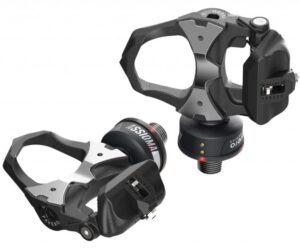
Garmin Rally RS200

2. Crank Arm Power Meter
A crank arm-based power meter measures the forces in the crank arm. 4iiii Innovations is one of the most well-known makers of this power meter type. These power meters are popular as they are typically affordable and easy to install. However, they only measure left leg power so in some situations, they won’t be as accurate as a power meter that measures both legs.
4iiii R7000

3. Spider Power Meter
Spider-based power meters measure power using a strain gauge positioned inside the spider. These are some of our best-selling power meters as they measure power from legs, are accurate and typically allow you to keep your existing crank arms and chainrings. In addition, some models from power2max, Sigeyi and Magene for example, are very affordable.
Sigeyi AXO

power2max NGeco

4. Crankset Power Meter
Power meter cranksets are typically the most expensive option as you are buying an entire crankset – crank arms, spider, spindle and sometimes chainrings too. However, these power meters allow riders to upgrade their entire crankset at once. In addition, they almost always measure power from both legs (there are some exceptions here) and sometimes they also measure independent left and right leg power.
ROTOR INpower V3

SRAM Force AXS
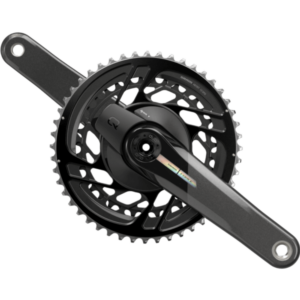
7. How to Choose the Right Power Meter
It’s important to understand that selecting and buying a power meter depends on a number of personal factors (your bike, budget, etc.). There is no such thing as ‘the best power meter’. The right power meter for you might not be good for the next person. We never recommend a power meter to a customer until we understand their own unique set of circumstances. For riders that are new to power meters, we recommend focusing on three areas: (1) Compatibility, (2) Features and (3) Price.
Or, you can use our PMC Power Up Tool. This allows you to view power meters based on factors that are most beneficial to you. For example, you can search by price, brand, power meter type, power measurement, compatibility, ease of use and more!
1. Compatibility
Compatibility simply refers to whether the power meter will fit with your current frame or components. For example, if you’re looking at a crank-based power meter, is it compatible with your frame and bottom bracket? Maybe you’re looking at a power meter pedal. Is it compatible with your shoes and cleats?
If the power meter you are interested in isn’t compatible with your bike or components, it’s time to look at another power meter. (Unless you’re willing to make a change to your components in order to accommodate the power meter.) The last thing you want to do is buy a power meter only to later find out it’s not compatible with your bike. So be sure to confirm compatibility before purchasing. All of our product listings contain a compatibility section – so you can look there for notes on compatibility, or give us a call and we can help.
In general, there are more options for the road then there are for the other cycling disciplines (mountain, track, cyclocross, etc.). However, as more power meters continue to enter the market, the other disciplines are quickly catching up.
2. Features
There are several features you will probably want to consider when buying a new power meter. We have listed them below in order – starting with the most important. But the order below is just how we look at power meters. Again, we all have our own unique set of considerations. Maybe you have to move a power meter between bikes, in which case transferability will be higher on your list. Alright, let’s check them out.
Accuracy
Accuracy refers to whether the power meter is indeed measuring what it claims to be measuring. For example, if it’s transmitting 225 watts to your head unit, are you actually producing 225 watts, or are you producing 215 watts instead? This must be listed first as it’s usually one of the more immediate things people think about when buying a power meter. However, the truth is, while accuracy is of course key when using any power meter, this is not something most cyclists need to worry much about. All the direct force power meters we carry are tried and true, and are very close to one another in terms of accuracy (+/- 1.5% or better) – assuming it is installed and calibrated correctly.
If absolute accuracy is your goal, there are some super precise power meters that have been certified accurate all the way up to +/- 0.5%. So, if that’s what you’re looking for, more power to you (pun intended). But again, for most cyclists, other features (and of course price), usually prove more important.
Reliability
Nothing is more frustrating than a piece of faulty equipment. You want your power meter to work and be reliable, every day. Reliability is key when looking at power meters so be sure to do some research in this regard. Fortunately, most of today’s units rank high in terms of reliability. Again, contact us here with questions.
Transferability
Transferability refers to how easy the power meter is to transfer from one bike to the next. If you have multiple bikes but only one power meter, it’s nice to be able to move the power meter from bike to bike. Some power meters are easy to transfer; others not so much.
Generally, the easiest power meters to transfer are pedal-based power meters and opposing force power meters, such as the PowerPod. Next easiest are usually crank arm-based power meters. Then there are crank- or spider-based power meters – which can be moved among bikes – but typically aren’t due to the time it would take to do so, as well as potential frame compatibility issues between your bikes.
Installation
Installation usually goes hand-in-hand with transferability. Power meters that are easy to transfer are usually easy to install. The easiest power meters to install are pedal and crank arm power meters. Spider or crank power meters on the other hand require more work. However, assuming you’ve purchased a power meter that is compatible with your bike and bottom bracket, even these are relatively straightforward to install and mostly require common tools.
In addition, assuming you’re not moving the power meter from bike to bike frequently, keep in mind that installation is a one-time thing. So even if the installation process is a bit more involved, don’t let this deter you too much if the power meter checks all of your other boxes.
Left/Right Measurement
Some power meters offer independent left/right power measurement. With this feature, you can measure how much power each leg is generating independently. While left/right power measurement is a very cool feature, there is some debate as to how meaningful this information is and whether you can, or even should, try to even out any imbalances you might find.
There are two types of left/right power – actual and estimated. Power meters such as ROTOR’s 2INpower SL or pedal-based power meters, measure both legs independently. They combine the data to give you total power. ROTOR does this by locating a power sensor on both crank arms. Whereas the pedals house a power sensor in each pedal.
On the other hand, spider-based power meters such as the Quarq power meter only estimate how much of your total power is coming from each leg. This is because there is only one power meter on the bike (in this case in the spider), so the power meter needs to make some assumptions. Specifically, they take power from your left and right down strokes (where most of your power is produced) in order to determine how much power each leg is producing separately. To be clear, this estimation is only in regards to your left and right power destitution. When it comes to calculating your total power (the important number!), they are very accurate and don’t have to make any estimates as all of your power passes through the spider.
Transmission Protocols
Your power meter will communicate with your bike computer, smartphone or tablet through one of two wireless protocols: ANT+ or Bluetooth SMART. Note that nowadays, most power meters are compatible with both.
ANT+
ANT+ is a 2.4 GHz wireless network which is used to send standard information wirelessly from one device to another. It allows your power meter to communicate with your head unit. All power meters and head units we sell are compatible with ANT+ technology.
Bluetooth SMART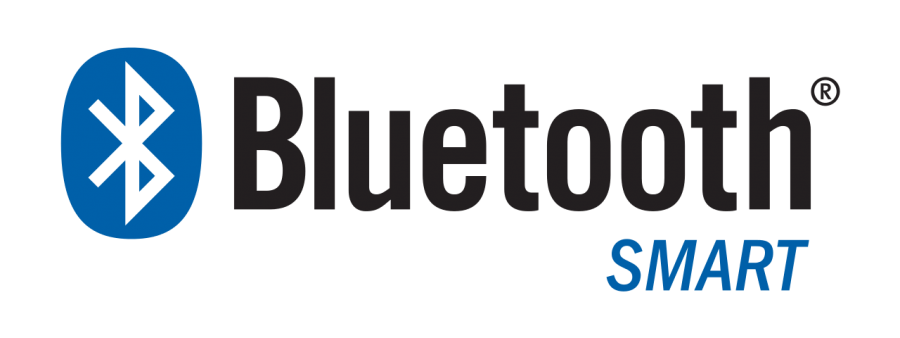
Bluetooth SMART technology is also a wireless protocol, however it allows you to connect your power meter with smart phones and tablets. It also allows for pairing with popular training apps such as Zwift.
Batteries
There are two aspects you might want to consider when looking at the battery for your power meter: battery type and battery life.
Battery Type
More and more power meters are coming with rechargeable lithium-ion batteries. Rechargeable batteries offer a bit of a trade-off. On one hand, you never have to worry about replacing the batteries in your power meter. However, rechargeable battery life is typically less than that of a replaceable battery.
 The most popular replaceable battery is the CR2032 coin-cell battery. These batteries are cheap and you can find them virtually anywhere. Other batteries that are used are AA (ROTOR INpower V3) or LR44/SR44 (Garmin Rally). We always recommend keeping a few batteries on hand to eliminate the risk of being without a battery when you need one.
The most popular replaceable battery is the CR2032 coin-cell battery. These batteries are cheap and you can find them virtually anywhere. Other batteries that are used are AA (ROTOR INpower V3) or LR44/SR44 (Garmin Rally). We always recommend keeping a few batteries on hand to eliminate the risk of being without a battery when you need one.
Battery Life
Battery life largely depends on the type of battery your power meter has. As mentioned previously, rechargeable batteries have a bit of shorter life. On average, power meters with rechargeable batteries typically get around 150 hours of battery life. However again, this is an average and some, such as the 4iiii PRECISION 3P+ get as much as 800 hours!
This compares to power meters with replaceable batteries which get closer to 250 hours on average. But again, the range is wide for this group as well as the ROTOR INpower V3 gets 300 hours while the Garmin Rally gets closer to 120 hours.
Weight
All power meters add weight, some more than others. Power meters such as a left-side only crank arm-based power meter might only add 10-20 grams to your bike, while others might add closer to 200-250 grams or more (but this all depends on the component you are replacing). When factoring in the weight, remember to focus on added weight by taking into account the component you’re replacing. For example, if the crank-based power meter you’re considering weighs 700 grams, and your current crank weighs 500 grams, the net addition is 200 grams.
While it’s important to pay attention to how much weight is added and where, it’s not worth fussing over. The benefits of training with power will more than offset any weight gain. If you’re a weight weenie (and we don’t say this is a bad way), weight might move up on your list. Otherwise, we think it’s safe to keep it here.
3. Price
Power meters start at around $220 and can reach $2,500 or more. Some of the more expensive power meters offer features like carbon fiber cranks, independent left/right power measurement and high levels of accuracy and consistency. However, this isn’t to say that a lower priced power meter can’t do the job. In fact, nothing could be further from the truth. The vast majority of power meters are very capable assuming you have them set up properly and calibrated – so don’t assume that more expensive is necessarily better. If you find a power meter that meets your criteria and is in your price range – than it’s likely a winner for you.
8. Cost/Benefit of Buying a Power Meter
So you’re convinced that a power meter is the single most effective training tool a cyclist can use for improving performance, but you think they are too expensive? We would argue differently. Cyclists often spend hundreds and sometimes thousands of dollars upgrading the components on their bike…and we can’t think of a single upgrade that can offer the potential gains that a power meter can. Power meters are simply an invaluable piece of technology when it comes to cycling performance.
In addition, due to the rise in popularity and the increased use of power meters across all cycling disciplines, more manufacturers have entered the market. More power meters results in a more competitive environment, which means lower prices. With prices now starting at $220, there is no reason not to be riding with power!
9. The Power Meter City Difference
We would be remiss if we didn’t briefly mention why we think we are best suited to help you when you’re ready to buy a power meter. (We’re biased…but we think we’re pretty great.)
At Power Meter City, we focus on ONE area and one area only: power meters. Unlike others, we don’t deal with other bike parts, clothing, miscellaneous accessories or anything else that can distract us from what we love – yes, power meters!
Here’s Why You Should Shop with Us!
We would be remiss if we didn’t briefly mention why we think we are best suited to help you with your bicycle parts needs. (We’re biased…but we think we’re pretty great.) Here are a few reasons you should shop with us:
![]() Large Selection: We have the largest selection of power meters, components and accessories
Large Selection: We have the largest selection of power meters, components and accessories
![]() Free Shipping: We offer free U.S. shipping on orders over $75
Free Shipping: We offer free U.S. shipping on orders over $75
![]() Fast Order Processing: We ship in-stock orders the same day your order is placed
Fast Order Processing: We ship in-stock orders the same day your order is placed
![]() Full Warranty: We are authorized dealers of every product we carry so you always get a manufacturer’s warranty
Full Warranty: We are authorized dealers of every product we carry so you always get a manufacturer’s warranty
![]() 30-Day Returns: We offer a 30-day return policy on all new items and returns and exchanges are easy
30-Day Returns: We offer a 30-day return policy on all new items and returns and exchanges are easy
![]() 5-Star Customer Support: We have a 5 star customer service rating on Trustpilot and some of the best reviews in the business
5-Star Customer Support: We have a 5 star customer service rating on Trustpilot and some of the best reviews in the business
Thanks for reading our 2024 Power Meter Buyer’s Guide. Please contact us with any questions!

 4iiii PRECISION 3+ Shimano R7000 Power Meter
4iiii PRECISION 3+ Shimano R7000 Power Meter  Favero Assioma DUO Power Meter Pedals
Favero Assioma DUO Power Meter Pedals  Sigeyi AXO SRAM MTB Power Meter
Sigeyi AXO SRAM MTB Power Meter 